Characterization and Thermochemical Properties of NC/GAP/nano⁃TATB Electrospinning Composite Fibers with 3D Network Structure
2020-09-17LUOTingtingWANGYiLIULixiaSONGXiaolan
LUO Ting⁃ting,WANG Yi*,LIU Li⁃xia,SONG Xiao⁃lan
(1.School of Materials Science and Engineering,North University of China,Taiyuan 030051,China;2.North Blasting Technology Co.,Ltd.,Yangquan Branch,Yangquan 045000,China;3.School of Environment and Safety Engineering,North University of China,Taiyuan 030051,China)
Abstract:A composite fiber nitrocellulose/glycidyl azide polymer/nanometer 1,3,5‑triamino‑2,4,6‑trinitrobenzene(NC/GAP/nano‑TATB)with three‑dimensional structure was prepared by electrospinning method. Differential scanning calorimeter(DSC)and online thermal‑infrared spectrometry(TG‑IR)measurement were conducted to probe the low temperature thermochemical properties of the composite fiber. Result indicates that there is only one exothermic peak existing in its DSC curve,which means that NC,GAP,and nano‑TATB decomposed simultaneously rather than decomposed individually. The activation energy(Ea)of NC/GAP/nano‑TATB(208.1 kJ·mol-1)is lower than nano‑TATB(228.9 kJ·mol-1),and the rate constant(k)of NC/GAP/na‑no‑TATB(1.70 s-1)is higher than nano‑TATB(0.92 s-1). The composite fiber is easier to be activated and will decompose faster than nano‑TATB. The main products for thermal decomposition of NC/GAP/nano‑TATB include CO2,N2O,NO,CO,NO2 and H2O,meanwhile,fragments like ─CH─,─CH2O,and C─O ─C were also detected. Moreover,the energetic performance and sensitivity of the composite fiber have been detailedly evaluated and compared with that of NC/GAP and nano‑TATB. Com‑bustion temperature(Tc)of NC/GAP/nano‑TATB is up to 1583 ℃and the addition of nano‑TATB is favorable to the reduction of impact sensitivity.
Key words:electrospinning;NC/GAP/nano‑TATB;thermal decomposition;energetic performance;sensitivity
1 Introduction
Energetic materials are extensively used in vari‑ous weapon systems[1-3]. With the development of modern weapons,energetic materials need to be fur‑ther improved,including higher density,higher re‑activity,lower sensitivity,higher burning rate and higher specific impulse[4-6]. For the same energetic material,compared with coarse size energetic mate‑rials,nano‑scale energetic materials have excellent properties such as high reaction rate and low sensi‑tivity. This is attributed to the intimated contact of the particles[7-9]. However,due to high surface ener‑gy,energetic nanoparticles are easily agglomerated.Energetic nanocomposites draw attention of re‑searchers,which consists of a nano‑matrix with en‑ergetic nanoparticles loading on it. This nano‑matrix can effectively hinder the agglomeration of nanopar‑ticles[10-13]. Nano‑TATB has features of high energy performance,smaller critical diameter,faster and more stable detonation wave propagation,in addi‑tion to retaining low sensitivity and high thermosta‑bility. Hence,nano‑TATB is a significant compo‑nent of energetic nanocomposites.
In recent years,electrospinning technology has been introduced to the fabrication of nanocompos‑ites. Its products,i.e. nanofiber,have net‑like struc‑tures with high specific surface area,which are ide‑al carriers for loading nanoparticles[14-21].However,only a few studies are conducted concerning the ap‑plication of electrospinning in the field of energetic nanocomposites. For example,Yan[22]obtained ni‑trocellulose/aluminum‑cupric oxide (NC/Al‑CuO)nanofibers with high burning rate. Nanoboron/nitro‑cellulose(B/NC)and nitrocellulose/2,4,6,8,10,12‑hexanitro‑2,4,6,8,10,12‑hexaazaisowurtzitane(NC/CL‑20) nanofibers were prepared based on electrospinning methed,and these nanofibers also burned violently[23-24].All of them choose NC as the martix of electrospun. In fact,in previous attempts,we have employed NC as the precusor to fabricate nanofibers loaded with explosive nanoparticles. It has been found that the rather high viscosity of the NC solution results in a quite low load of explosive nanoparticles and high electrospinning voltage. In this sense,if you want to increase the load,it is in‑dispensable to lower the viscosity of the precusor so‑lution. Decreasing the concentration of NC will lead to a penalty in the structure of nanofibers. In this re‑gard,using or introducing a precusor with low vis‑cosity may be a good choice in the case of a com‑posite nanofiber with high load of explosive nanoparticles. GAP is an energetic prepolymer with low viscosity and high energy[25].Meanwhile,it has remarkably lower glass transition temperature(Tg)and higher density than NC[26]. At present,no at‑tempt has been made that involves using GAP as a precusor to fabricate nanofibers with electrospun. In the present paper,partial NC is replaced by GAP to reduce the viscosity of electrospinning solution.Meanwhile,the safety problems caused by high electrospinning voltage can be avoided effectively.The TATB nanoparticles are loaded on the compos‑ite matrix of NC/GAP by an electrospinning method to obtain a NC/GAP/nano‑TATB nanofiber. Analyses such as SEM,EDS,XRD,IR,and XPS are em‑ployed to investigate the morphology structures of samples. DSC and TG‑IR analyses are conducted to probe the low temperature thermochemical proper‑ties of the composite fiber. The energy performance of the NC/GAP/nano‑TATB nanofibers are analyzed from the perspective of the formation enthalpy(ΔHf),oxygen balance(OB),and C/H mass ratio.
2 Experimental
2.1 Materials
Nitrocellulose(NC,12.6% N,industrial grade)is purchased from Foshan Junyuan Chemical Co.,Ltd(Foshan,China). Glycidylazide polymer(GAP,Mn=4000,hydroxyl value of 0.49 mmol·g-1)is pro‑vided by the 42ndInstitute of the Fourth Academy of China Aerosce Science and Technology Corpora‑tion. Raw TATB is purchased from Gansu Yinguang Chemical Co., Ltd (Baiyin, China). Ethanol(EtOH) and acetone are purchased from Tianjin Guangfu Chemical Co.,Ltd(Tianjin,China).
2.2 Preparation of NC/GAP/nano⁃TATB nanofiber
Nano‑TATB is obtained by the ball milling meth‑od. The ingredients,including 200 g balls,6 g TATB,60 mL water and 60 mL EtOH,are added in‑to a mill jar. The jar is sealed and fixed on the ball mill. The planet carrier rotates at 350 r·min-1for 6 h.The TATB nanoparticles are separated from the sus‑pension and are dehumidified by freeze drying.
NC/GAP/nano‑TATB nanofiber is prepared as follows. The mass ratio of NC,GAP,and nano‑TATB is set to 3∶3∶2. Firstly,the nano‑TATB suspension is prepared by dispersing 0.3 g nano‑TATB into 4.4 g acetone,and the NC/GAP solution is obtained via dissolving 0.45 g NC and 0.45 g GAP into 4.4 g ace‑tone. Then,the above‑synthesized nano‑TATB sus‑pension and NC/GAP solution are mixed to get a NC/GAP/nano‑TATB precursor solution(12%). For the electrospinning process,the inner diameter of the stainless steel needle is 0.8 mm. Moreover,the flow rate is 4‑6 mL·h-1,and the applied voltage is fixed at 12-18 kV. The collection distance is 12 cm.Eventually,the electrospun nanofibers deposit on the aluminum foil. The preparation scheme of NC/GAP/nano‑TATB is described in Fig.1.
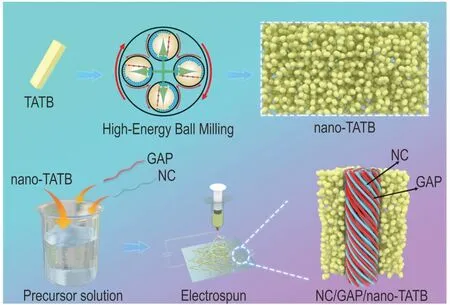
Fig.1 Sketch for the synthesis of NC/GAP/nano‑TATB com‑posite nanofiber
For contrast experiment,the NC/GAP precursor solution(12%)is synthesized by dissolving 0.6 g NC and 0.6 g GAP into 8.8 g acetone. The electros‑pinning process of NC/GAP is the same as that of NC/GAP/nano‑TATB nanofiber.
2.3 Characterization
The morphologies of nanofiber and nano‑TATB are observed by a scanning electron microscope(SEM, Hitachi SU8010). The X‑ray diffraction(XRD)analysis is performed on a DX‑2700 X‑ray dif‑fractometer(Haoyuan)with CuKαradiation. IR spec‑trum is obtained on an infrared spectrometer(Ameri‑can Thermo Fisher Scientific Nicolet 6700). XPS is conducted with X‑ray photoelectron spectroscopy(XPS)and a PHI5000 Versa‑Probe(ULVAC‑PHI).The BET measurements are performed utilizing the nitrogen adsorption with Micromeritics ASAP 2010 instrument. Thermal analysis is conducted on a dif‑ferential scanning calorimeter (DSC, TA Model Q600)at heating rates of 5,10,15 ℃·min-1and 20 ℃·min-1. TG‑IR analysis is performed on a ther‑mal analyzer system(TG/DSC,Mettler Toledo)cou‑pled with a Fourier transform infrared spectrometer in nitrogen atmosphere. The impact sensitivity is de‑tected using an HGZ‑1 impact equipment and refer‑ring to the method in GJB772A-97. The drop ball used in the test is 2.5 kg, and the dosage is(35±1)mg each time.Each sample is tested 25 times.
3 Results and Discussion
3.1 Morphology and structure
As is shown in Fig.2a,the nano‑TATB presents the micron morpholgy of ellipsoid. The particles di‑ameter distribution of nano‑TATB are calculated via measuring a diameter of -100 particles,and the re‑sults are shown in Fig.2b. The mean diameter calcu‑lated by the frequency curve is 133.3 nm. Fig. 3 shows that the NC/GAP and NC/GAP/nano‑TATB nanofbers both keep three‑dimensional reticulation morphologies. Form Fig.3a,the surface of NC/GAP is smooth and uniform. With Fig.3b in comparison,the nano‑TATB is entrapped on the surface of the NC/GAP nanofibers,and the surface morphology of NC/GAP/nano‑TATB is rough and inhomogenous.This distinction is put down to the factors that the ad‑dition of nano‑TATB makes the NC/GAP/nano‑TATB precursor solution not as homogeneous as the pure NC/GAP solution. In addition,it is probably caused by the aggregation of nano‑TATB. For the NC/GAP nanofibers,the mean diameter are 469 nm. For the NC/GAP/nano‑TATB nanofibers,the mean diameter is 1036 nm. It is evident that the diameter of NC/GAP/nano‑TATB is larger than that of NC/GAP,which is beacause there are TATB nanoparticles in‑corporating on the surface of NC/GAP.
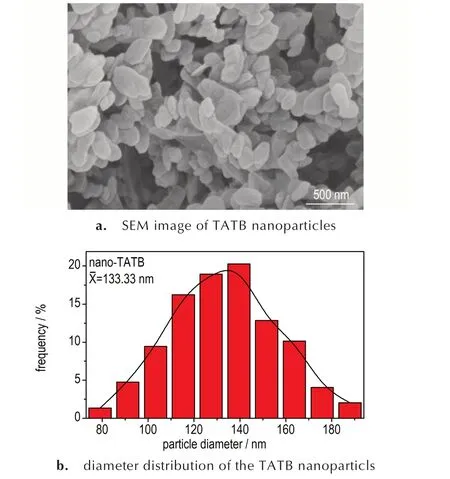
Fig.2 Morphology analysis of TATB
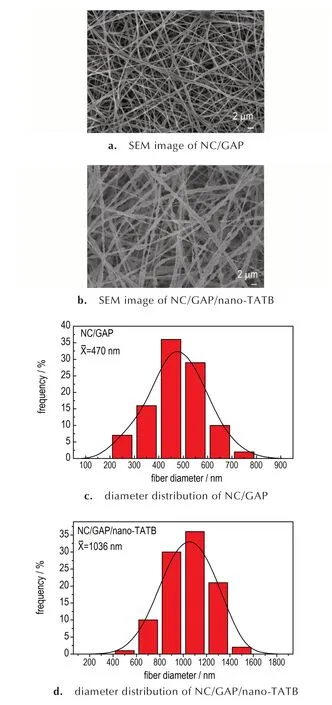
Fig.3 Morphology analysis of fibers
The EDS spectrograms of NC/GAP and NC/GAP/nano‑TATB are illustrated in Fig.4. It can be found that only the characteristic peaks of C,N and O elements appear. The calculation results of de‑tailed elements content for NC/GAP and NC/GAP/nano‑TATB are listed in Table 1. It is confirmed that after coating nano‑TATB,there is no change in O content,N content significantly increases and C content declines.

Fig.4 EDS spectra of samples

Table 1 Theoretical element contents of EDS analysis
To illustrate the surface groups of the NC/GAP/nano‑TATB nanofibers,IR analyses of samples are conducted,and the IR spectra are dispalyed in Fig.5.For the NC/GAP nanofibers,two absorption peaks sit‑uated at 1280 cm-1and 1650 cm-1represent the sym‑metric and anti‑symmetric stretching vibrations of─ONO2. The peaks at 1068 cm-1and 848 cm-1refer to the inter‑ring stretching vibrations of C ─O and C─O─NO2deformation vibrations. All these vibra‑tions match with the molecular structure of NC[27].The peak at 2100 cm-1reflects the stretching vibrations of─N3in GAP[28]. In light of nano‑TATB,the peaks at 3310 cm-1and 3213cm‑1refer to the symmetric and anti‑symmetric stretching vibrations of Ar ─NH2,respectively. The peaks at 1613,1561 cm-1,and 1438 cm-1indicate the stretching vibrations of the C=C skeleton in the benzene ring. Two strong ab‑sorption peaks located at 1221 cm-1and 1174 cm-1correspond to the symmetric and antisymmetric stretching vibrations of Ar ─NO2[29]. All these peaks in NC/GAP and nano‑TATB also exist in the spec‑trum of NC/GAP/nano‑TATB. The XRD patterns of samples are shown in Fig.6. NC/GAP is an energetic polymer. Hense,there are only dispersion peak in the pattern of NC/GAP. Nano‑TATB shows character‑istic peaks at 28.36° and 42.27°,where the peaks of NC/GAP/nano‑TATB also occur.
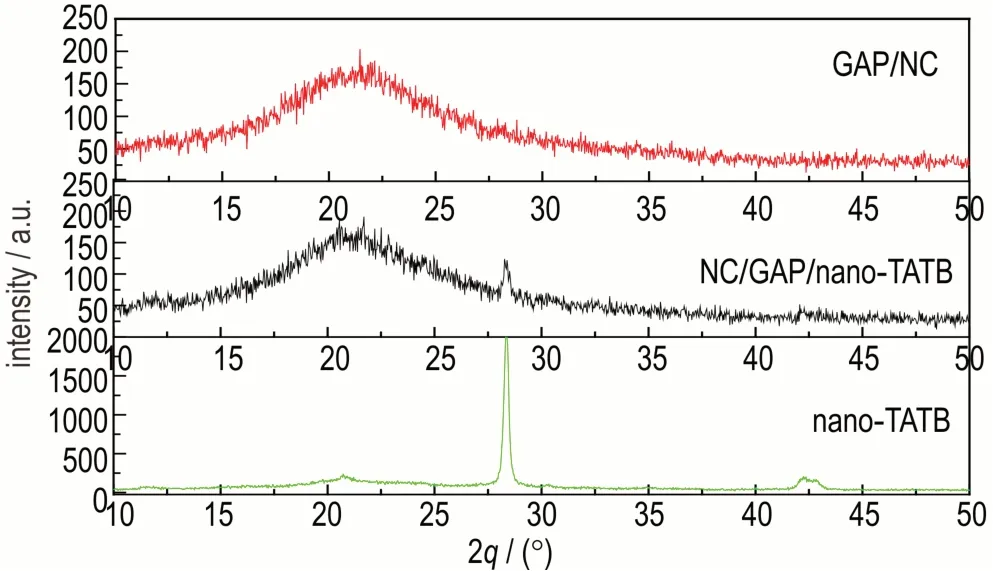
Fig.6 XRD patterns of samples
For the NC/GAP/nano‑TATB nanofibers, the chemical states of surface elements are further investi‑gated by XPS. Fig.7a shows that the nanofibers are composed of carbon,nitrogen and oxygen elements.The high‑resolution XPS spectra of C,N and O ele‑ments are exhibited in Fig.7b‑7d. The O 1s spectra is fitted to four peaks. The peak at 532.5 eV relates to─NO2in TATB[30]. The peaks at 533.5 eV and 534.2 eV belong to ─O*─NO2and ─O─NO*2in NC[31]. The peak at 531.4 eV is ascribed to the C─O group in NC and GAP. The C 1s spectrum presents three features binding energies of 284.3,286.3 eV and 288.4 eV corresponding to C ─C,C ─N,and C─O,respectively. The XPS spectrum of N 1s con‑sists of four peaks at 399.3,400.4,404.0 eV,and 407.5 eV,which are assigned to ─NH2,─N3,─NO2and ─ONO2[32]. The ─N3and ─ONO2groups imply the presence of GAP and NC in the nanofibers.The groups of ─NH2and ─NO2belong to TATB,which illustrates the loading of nano‑TATB on the surface of NC/GAP.

Fig.7 XPS spectra of of samples
The Nitrogen adsorption‑desorption isotherms of the NC/GAP and NC/GAP/nano‑TATB nanofibers are shown in Fig.8. And the BET specific surface ar‑eas,pore volumes and pore sizes of the nanofibers are listed in Table 2. From Fig.8,the isotherms are regarded as class IV(H3‑type hysteresis loop),cor‑responding to the mesoporous material[33]. The in‑flection point B usually corresponds to the comple‑tion of the single layer adsorption,which is initially similar to the adsorption process of macroporous ma‑terials. The capillary condensation causes the sharp rise of adsorption. Capillary condensation and capil‑lary evaporation generally do not occur under the samep/po,which leads to the creation of hysteresis loops[34]. The surface area of the NC/GAP nanofibers(4.3573 m2·g-1)is larger than that of the NC/GAP/nano‑TATB nanofibers (4.2331 m2·g-1). It results from the lower diameter of NC/GAP nanofibers.

Fig.8 The BET data of samples
3.2 Thermal analysis
The DSC curves of NC/GAP,nano‑TATB and NC/GAP/nano‑TATB collected at different heating rates are displayed in Fig.9,and they are utilized to calculate the kinetic and thermodynamic parameters in Table 3. For all samples,the exothermic peak tem‑perature increases with the increase of heating rate.For NC/GAP and nano‑TATB,there is only one exo‑thermic peak. In regard to the NC/GAP/nano‑TATB nanofibers,at the heating rate of 5 ℃·min-1,there are two exothermic peaks in DSC curve. However,as the heating rate increases to 10,15 ℃·min-1,and 20 ℃·min-1,only one peak exists. This means that they decompose simultaneously at high heating rates. The thermal decomposition rate of NC/GAP/nano‑TATB is significantly higher than those of NC/GAP and nano‑TATB. In addition,the exothermic peak temperature of the NC/GAP/nano‑TATB nanofi‑bers is markedly lower than those of the NC/GAP nanofibers and nano‑TATB,which indicates that NC,GAP and nano‑TATB provide synergistic effects for the thermal decomposition. This might be due to that the nanofibers with large specific surface area possess excellent thermal conductivity and heat mass transfer properties.

Table 2 BET surface area and pore structure parameters of nanofibers
The Activation energy(Ea),pre‑exponential fac‑tor(AK),and rate constant(k)are calculated with Kissinger equation(Eqs.(1))and Arrhenius equa‑tion(Eqs.(2))[35]. TheEaof NC/GAP/nano‑TATB is 208.124 kJ·mol-1, which is higher than that of NC/GAP and is lower than that of nano‑TATB. The introduction of nano‑TATB facilitates the activation of nanofibers. Thekof NC/GAP/nano‑TATB is hgher than that of nano‑TATB and NC/GAP,demonstrat‑ing that the thermal decomposition of NC/GAP/nano‑TATB is faster than that of NC/GAP and nano‑TATB.
The essence of thermal decomposition is the ac‑tivation and fracture of the explosive molecular bonds. When the explosive molecules are heated,the molecular thermal motion intensifies. At the criti‑cal temperature,the weakest bonds are stretched.When stretching to the limit,the fracture of the weakest bonds occur,accompanying with a change in energy. The activation process of explosives is an endothermic process,which is depicted by the ther‑modynamic parameters of ΔG≠(free energy of acti‑vation),ΔH≠(enthalpy activation),and ΔS≠(entro‑py of activation)calculated via Eqs.(3)-(5). ΔG≠means the chemical potential of the explosive mole‑cule in the activation reaction,whose values are positive numbers. This signifies that all of activation processes are non‑spontaneou[36]. Hence,the explo‑sives remain steady under normal conditions. ΔH≠represents the required energy of molecular activa‑tion,which is similar to the definition ofEa. The ki‑netic compensation effect for the thermolysis of NC/GAP,nano‑TATB and NC/GAP/nano‑TATB are displayed in Fig. 9e. It is clear that the points of NC/GAP,NC/GAP/nano‑TATB and nano‑TATB do not present a linear relationships. This implies that the three samples have disparate decomposition mechanisms in kinetics.

whereTpis the peak temperature in the DSC trace with a heating rate of 15 ℃·min-1;KBandhare the Boltzmann(KB=1.381×10-23J·K-1)and Planck con‑stants(h=6.626 × 10‑34J/s),respectively;βis the heating rate.
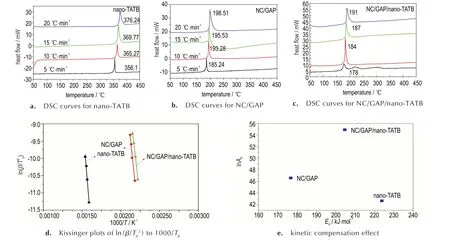
Fig.9 Thermal decomposition analysis of samples

Table 3 Thermodynamics and kinetics deduced from DSC traces
With regard to the NC/GAP/nano‑TATB nanofi‑bers,the products and mechanism of thermal de‑composition are assessed by TG‑IR. The TG and DTG curves are exhibited in Fig.10a,and the IR pat‑terns intercepted at different temperature are dis‑played in Fig.10b. From Fig.10a,the incipient de‑composition temperature of NC/GAP/nano‑TATB is about 198 ℃. The decomposition rate reaches its maximum value at point of 203 ℃and the decompo‑sition is accomplished at 214 ℃. In Fig. 10b,at 3740 cm-1and 1556-1610 cm-1,the peaks corre‑spond to H2O and NO2. At 1182-1185 cm-1,the peak reflects the fragments of ─C ─O ─C ─. The peak at 2116-2201 cm-1represents the generation of CO. The peak at 1883-1924 cm-1indicates the presence of NO. The existence of CO2explains the peak located at 2311-2361 cm-1. The peaks at 1664-1794 cm-1and 3230-3331 cm-1are in accor‑dance with the ─CH2O and ─CH debris,respec‑tively. The ─ONO2is the energetic group of NC,and the energetic groups of TATB are ─NO2and─NH2. The ·NO2radical reacts with ─NH2and─C to produce N2O,NO2,NO,CO and CO2[37].The ─N3group,which is the energetic group of GAP,decomposes to N2. N2has no infrared absorp‑tion and can not be probed by IR. The signal of CO is relatively strong,which is due to the large negative oxygen balance coefficient of NC/GAP/nano‑TATB.

Fig.10 TG‑IR analysis of samples
3.3 Energy properties and sensitivities
To explore the energy properties of NC/GAP/na‑no‑TATB,the impact sensitivities and energy perfor‑mances of the samples are tested.The standard specif‑ic impulse(Isp),characteristic velocity(C*),combus‑tion chamber temperature(Tc)and average molecular mass of combustion products(Mc)are calculated and the results are listed in Table 4. Meanwhile,the com‑bustion products and their molar ratios are also calcu‑lated,and the results are shown in Fig.12. Moreover,the speciality height(H50),characterizing the impact sensitivity of samples,are tested and listed in Table 4.Obviously,the addition of nano‑TATB brings about an evident decrease ofH50for NC/GAP,indicating that the NC/GAP/nano‑TATB nanofibers possess low‑er sensitivity than NC/GAP. For energy performance,theIspof NC/GAP/nano‑TATB and NC/GAP propel‑lant are 2000.9 N·s·kg-1and 2013.8 N·s·kg-1,re‑spectively. This phenomenon is associated with the formation enthalpy(ΔHf),oxygen balance(OB),and C/H mass ratio of the samples. The working course of propellant is an effective transformation process to convert chemical energy into heat energy and transform heat energy into kinetic energy by act‑ing[37-38]. Hence,chemical energy storage and ener‑gy conversion efficiency are crucial factors to energy performance. The former is represented byTc,which is relevant to formation enthalpy(ΔHf),oxy‑gen balance(OB)and C/H mass ratio. As formation enthalpy(ΔHf),oxygen balance(OB)and C/H mass ratio increase,the value ofTcincreases. The forma‑tion enthalpy of nano‑TATB is -139.75 kJ·mol-1,which is observably larger than that of NC/GAP(-294.6 kJ·mol-1). The C/H value of nano‑TATB(8.6)is higher than the C/H value of NC/GAP(8.1).The(OB)of NC/GAP and nano‑TATB are -76.1 and-55.78,respectively. Hence,the addition of na‑no‑TATB is beneficial to the increase of chemical en‑ergy storage for NC/GAP. Fig.11c shows that com‑bustion chamber temperature(Tc)improves with the mass percent of TATB increasing. The energy conver‑sion efficiency is inversely proportional toMc. The reduction of hydrogen content causes that H2ratio in combustion products decreases andMcincreases.The hydrogen content of TATB is lower than that of NC/GAP. As is shown in Fig.11d,the value ofMcen‑hances with the increasing of TATB. Fig.12 shows that the H2molar ratio for TATB(21%)is lower than NC/GAP(28%). The incorporation of TATB leads to a decrease of energy conversion efficiency for NC/GAP. In this case,in spite of higherTcof TATB,the TATB has lowerIspthan NC/GAP. It is because the high storage of chemical energy of TATB is counter‑acted by the negative effect of low energy conver‑sion efficiency. Hence,the interposition of TATB slightly reduces the energy performance of NC/GAP.

Table 4 Impact sensitivity and energy performance of samples

Fig.11 Energy performances of NC/GAP/TATB nanofibers as a function of mass percentage of TATB

Fig.12 Combustion products and their molar ratios
Ispis Standard specific impulse;C* is Character‑istic speed;Tcis Combustion chamber temperature;Mcis Average molecular mass of combustion prod‑ucts. All the parameters were calculated by means of software ProPep 3.0 at condition ofpc/pe=70/1(pe=0.1 MPa)andT0=298 K.
4 Conclusions
In the present paper,the NC/GAP/nano‑TATB nanofiber with a 3D net structure is obtained by an electrospinning method. The energetic groups of─ONO2,─N3,─NO2and ─NH2are detected on the surface of NC/GAP/nano‑TATB nanofibers.
For thermolysis,the NC/GAP/nano‑TATB nano‑fibers decompose at the temperature range of 198~214 ℃. There is only one thermal decomposition peak. The various components of nanofibers play a synergistic role in thermolysis. TheEaof NC/GAP/na‑no‑TATB is 208.124 kJ·mol-1,which is higher than that of NC/GAP. Thekof NC/GAP/nano‑TATB(1.7 s-1)is hgher than that of nano‑TATB(0.92 s-1)and NC/GAP(1.43 s-1). The decomposition products of NC/GAP/nano‑TATB include NO,NO2,N2O,H2O,CO and CO2.
The addition of TATB results in an improvement of combustion chamber temperature(Tc)and aver‑age molecular mass of combustion products(Mc).TheIspof NC/GAP/nano‑TATB(2000.9 N·s·kg-1)is observably higher than TATB and slightly lower than NC/GAP.Mcplay a dominant role in energy perfor‑mance. TheH50of NC/GAP/nano‑TATB is up to 90.87 cm,which is higher than that of NC/GAP(59.28 cm). The introduction of TATB reduces the impact sensitivity of NC/GAP. Overall,the NC/GAP/nano‑TATB nanofibers possess distinguished energy properties of higher specific impulse and lower im‑pact sensitivity. This paper reveals the preferable ap‑plication potential in the weapon energy system,es‑pecially in the solid rocket‑propellant field.
